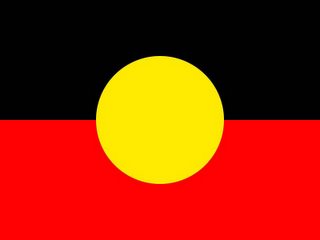However, for Aboriginal Australians and many others, the 26th of January is not a day for celebration. To them the date signifies invasion and dispossession. As Thomas Keneally noted in his 1997 Australia Day address -
"A majority of Australians can see why today cannot be a day of rejoicing for all, and that therefore there may be grounds for ultimately finding an Australia Day, a celebration of our community, with which we can all identify."The choice of 26 January as the day of celebration for all Australians has been queried and argued from a historical and practical viewpoint from the 1800s. That the day might symbolise invasion, dispossession and death to many Aboriginal people was a concept alien to the average Australian until even the latter half of the 20th century. The Editorial in the Sydney Morning Herald of 2 January 1995, arguing for a change of date, stated that January 26 "can never be a truly national day for it symbolises to many Aborigines the date they were conquered and their lands occupied. This divisive aspect to 26 January, the commemoration of the landing at Sydney Cove, will never be reconciled".
Involvement of the Indigenous community on Australia Day has taken many forms - forced participation in re-enactments, mourning for Invasion Day, peaceful protest through to an acknowledgment of survival and an increasing participation in community events at a local level.
By 1888, the year of the centenary celebrations, the white population had increased significantly while the Aboriginal population had declined from at least 750,000 in 1788 to a mere estimated 67,000. (Aboriginal people were not counted in the census until after 1967). The 1888 Centenary events overwhelmingly celebrated British and Australian achievement and as Nigel Parbury writes in his book Survival: ”In 1888 Aboriginals boycotted the Centenary celebrations. Nobody noticed.”
By 1938, the Aboriginal community was becoming well organised in the white ways and able to make strong demands for political rights and equality. An Australian Aborigines League (AAL) had been formed in 1932 and this was followed in 1937 by the Aborigines Progressive Association (APA), a group that began to achieve publicity in the press and addressed a variety of groups such as the NSW Labor Council.
The AAL leader William Cooper and the APA's leader William Ferguson, were instrumental in organising the Day of Mourning Committee for the 1938 Sesquicentenary celebrations. A manifesto, Aborigines Claim Citizen Rights, was published and on Australia Day a conference and protest were held in the Australian Hall, Sydney. Five days later, the APA led an Aboriginal delegation to meet with the Prime Minister and soon after Australia Day, the Committee for Aboriginal Citizen Rights was formed.
The Aboriginal community's push for recognition was highlighted by the 1938 official Australia Day celebrations. Due to a refusal to cooperate by city-based Aborigines, the government imported Aborigines from western communities, locking them up in a stable at Redfern Police Barracks. Immediately following the re-enactment, the group featured on a float in the huge parade in Macquarie Street. The following day they were “sent back to their tin sheds on the Darling River”.
Re-enactments of Phillip's landing continued to be an accepted part of Australia Day ceremonies around the country and it wasn't until the Bicentennial in 1988 that the New South Wales government refused to condone a re-enactment as part of their official proceedings.
On January 26 that year, 40,000 Aboriginal people (including some from as far away as Arnhem Land in the Northern Territory) and their supporters marched from Redfern Park to a public rally at Hyde Park and then on to Sydney Harbour to mark the 200th anniversary of invasion.
From this march grew the concept of "Invasion Day" and "Survival Day", marking the anniversary of the beginning of land loss, but also recognising the survival of a race of people who had been expected to die out. In 1992 the first Survival Day concert was held at La Perouse and in 1998 the event moved to Waverley Oval near Bondi Beach.

The Aboriginal Flag was designed by Harold Thomas, an artist and a Luritja man from Central Australia, in 1971. The flag was designed to be an eye-catching rallying symbol for the Aboriginal people and a symbol of their race and identity. The black represents the Aboriginal people, the red the earth and their spiritual relationship to the land, and the yellow the sun, the giver of life.
In the late 1960s, Aborigines stepped up their campaign for indigenous land rights through protest marches, demonstrations, banners and posters. The protests increased in the early 1970s and Harold Thomas noticed they were often outnumbered by non-Aborigines with their own banners and placards. He decided they needed to be more visible and the idea of the flag was born.
The Aboriginal flag was first raised in Victoria Square in Adelaide on National Aboriginal Day in 1971, but was adopted nationally by Aborigines and Torres Strait Islanders in 1972 after it was flown above the Aboriginal "Tent Embassy" outside of the old Parliament House in Canberra.
It is perhaps the only symbol commonly accepted by the diversity of Aboriginal people.
The Aboriginal flag is increasingly being flown by both Aboriginal and non-Aboriginal people. In view of its increasing importance in Australian society, the Government initiated steps in 1994 to give the flag legal recognition. After a period of public consultation, the Government made its own decision in July 1995 that the flag should be proclaimed a "Flag of Australia" under section 5 of the Flags Act 1953. The flag was so proclaimed by the Governor General of Australia, William Hayden, on 14 July 1995.
(compiled from various sources, all of which, except for the one below, have succumbed to the endemic web disease of link rot)
http://www.cityofsydney.nsw.gov.au/barani/themes/theme6.htm
recycled from pelican dreaming, 1/26/06.
No comments:
Post a Comment